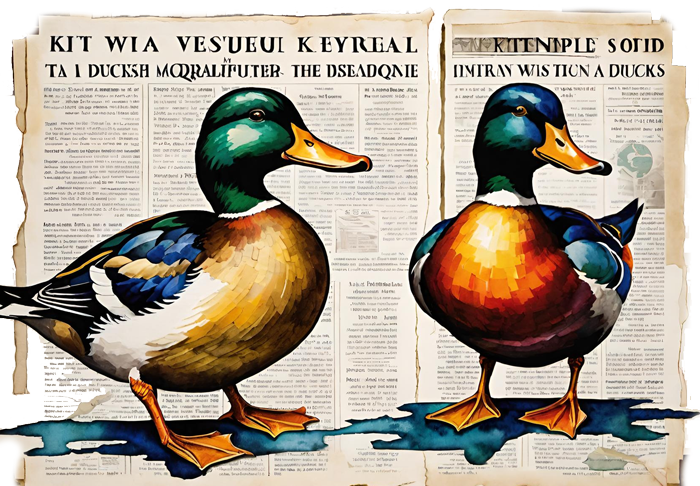Struggling to keep up with the rapid changes in SEO and search engine algorithms? Don’t get left behind! DuckByte is here to help you stay ahead of the curve and ensure your site makes a splash in the crowded digital pond.
Indeed, DuckByte’s got the word on the street about the essential SEO tips for crafting effective web content.
In March 2024, Google implemented a massive shift in its SEO protocols, focusing on what they call “helpful, reliable, people-first content.” This major change moves away from outdated keyword stuffing tactics and instead emphasizes genuinely valuable information, benefiting both users and website owners.
Alesia Lloyd, Co-Owner of DuckByte and an authority in web development and SEO content creation offers this insight: “I’ve been building websites and crafting content since before the time of Google! Over the years, I’ve seen SEO get out-gamed by manipulative marketing tactics: think of stuffing keywords into the footer of each page of your website and masking with white text on a white background… so as it be invisible to the reader but visible to the search engine crawlers —It was pretty much no holds barred… this shift that Google has undertaken has been a long time coming!!”
What Google’s SEO Content paradigm shift means for your business
For small to medium businesses like yours, this update is a game changer. It means that high-quality, relevant content will stand out more effectively in search results, giving your business a significant edge. This isn’t just a win for your SEO strategy; it’s a win for your business and your customers alike.

At DuckByte, we’re here to guide you through the journey of optimizing your web content with our blend of expertise and a touch of fun.
Let’s dive into the pond and explore essential SEO tips to help your website rankings soar…
Understanding Google’s Ranking Recommendations
It’s just a fact: with over 90% share of the global search market across all platforms, Google is the most popular search engine in the world, and its ranking recommendations play a crucial role in how website content should be optimized.
By following these simplified guidelines we outline below, we’ll make sure your content quacks up with both user-friendliness and search-engine-friendliness.
Text-to-Image Ratio
The first thing to note is that Google prefers a balanced ratio of 60% text to 40% images. This ratio ensures that your content is rich with information while also being visually appealing. Too many images can slow down your site and indicate you don’t have much to say, while too much text without visual breaks can be overwhelming for visitors. Aiming for this balance creates engaging content that keeps visitors on your site longer.
With DuckByte’s expertise in both visual design and layout, and especially now with the advent of AI graphics, we can help you excel at achieving this perfect balance and offer these services to help optimize your website content seamlessly.

Achieve the perfect design balance with DuckByte—where visual expertise meets AI innovation for seamless website optimization.
People-First Content
Creating readable, informative, and authoritative content relevant to your industry should be your priamay goal. Your website content needs to be designed to engage the visitor’s interest and offer them some value, rather than just exist to manipulate search engine rankings (Trust us, Google will know the difference). Here are some tips for creating your user-friendly content:
- Avoid Keyword Stuffing: Overloading your content with keywords to manipulate rankings can lead to penalties from search engines. Instead, focus on naturally incorporating relevant keywords.
- Engaging Copy: Write content that addresses the needs and interests of your audience. This approach will keep them engaged and encourage them to explore more of your site.
- Clear Structure: Use headings, subheadings, bullet points, and short paragraphs to make your content easy to read and navigate.

DuckByte, where old-school print layout expertise meets modern website SEO. Eelevate your site with our unique blend of skill and innovation. Get in Touch!
Focus on Consistency in Text that incorporates your SEO Keywords
After writing your website content, it’s important to ensure that your final version maintains consistent keyword targeting throughout your page, which is crucial for SEO.
- Header Text: Ensure that your headers include relevant keywords and match the content that follows. This alignment helps search engines understand the main topics of your pages.
- Body Text: Incorporate keywords naturally within the body text. Avoid forcing them into sentences where they don’t fit organically.
- Alt Text for Images: Use descriptive alt text for images that include relevant keywords. This practice not only helps with SEO but also improves accessibility for visually impaired users.
- Link Text: When adding links, use descriptive anchor text that includes keywords relevant to the linked content. This practice helps search engines understand the context of the links.
Organic SEO Over Intensive Keyword Research
While keyword research and strategizing has been an important aspect of SEO, it’s becoming more beneficial to focus on organic or “On Page” SEO. This approach emphasizes creating valuable content that naturally incorporates relevant keywords, rather than forcing them into your text to meet perceived market demands.

Think of orgnaic SEO as a duck gliding effortlessly downstream with the natural keywords, rather than paddling upstream against the current. Get in Touch Today!
- Quality Content: Focus on creating high-quality content that provides real value to your audience. When your content is valuable, it naturally attracts more visitors and engagement, and Google will readily serve it up to your potential clients.
- Natural Keyword Integration: Integrate keywords in a way that feels natural and enhances the readability of your content, rather than detracting from it. This approach will help you stand out to Google, build trust with your audience, and improve your search engine rankings.
Pro Tip:
Once you get your new copy up, you can monitor your SEO with Google Search Console. After a few weeks, look for pages ranking in the midrange for specific keywords, and then go back in and enhance those pages with additional informative body copy that includes that keyword. This will organically boost your presence on that term and help drive more organic traffic to your website.
A word of Caution: Avoid Redundant Page Content
It’s important to mention that using the exact same text on multiple pages of your site can ruffle Google’s SEO feathers. Instead, use unique content on each page to provide value and context. For example:
- Teaser Text: On your home page, use teaser text that encourages visitors to click through to other pages for more information. This strategy not only improves SEO but also enhances user engagement.
- Avoid duplicating blog post content across different pages or blogs. Google may view this as an attempt to manipulate rankings and could penalize your site. Ensure each post provides fresh, unique content to maintain credibility and SEO performance.
- Product Descriptions: Avoid using the same descriptions for multiple products, especially when sourcing content from manufacturers.
The hero we’ve all been waiting for…
“Google’s core shift to a human-first approach is the hero we’ve all been waiting for. It’s transforming SEO from an outdated game into a genuinely human-centric experience—especially crucial in the age of AI. Now, both online businesses and their potential clients can truly benefit from authentic, meaningful content.”
— Alesia Lloyd, DuckByte co-founder (About Aleisa)


The DuckByte team works diligently, focusing on Organic SEO. Prioritizing creating valuable, natural content and crafting it into a design that flows naturally, like a duck gliding gracefully downstream. About Us
Icing on the SEO Cake, Finalizing Your Website Copy and Images
Once your website copy and images are finalized, it is essential to go back and optimize them for SEO. Just like a duck needs to preen its feathers, make sure your content is in top shape by following these steps:
- Add Alt Text: Ensure all images have descriptive alt text that includes relevant keywords.
- Meta Descriptions: Write compelling meta descriptions for each page that accurately describe the content and include relevant keywords.
- Header Text Tweaks: Review your header text to ensure it aligns with your SEO strategy and make any necessary tweaks.
DuckByte has found that building your website with these SEO practices in mind from the start is the best way to ensure long-term success. While adjustments can certainly be made to your website content afterward, it’s much easier to implement these best practice SEO strategies during the initial development phase. At DuckByte, with our extensive experience in writing, language, and web design—seriously since the dawn of the World Wide Web, you’ve found the right ducks for the job! (See our Work Page)
At DuckByte, we’re here to help you navigate the waters of SEO and web content optimization. Reach out and let us know how DuckByte can help you get your existing or new website more SEO-enhanced. Don’t just wing it—let’s quack the code to a successful online presence together! (Contact DuckByte)
About the Author:
Alesia Lloyd, Co-Owner of DuckByte, is deeply passionate about how consciousness, language, and culture intersect with technology. She sees how language shapes and transforms our interactions as a society and is keen to promote this to foster a sense of unity in the human experience.
About AI: Alesia strongly supports maintaining the human element in the world of AI. While she believes in using these tools for their intended purposes, she warns against becoming too entangled in their seductive promises, which can sometimes fall short of their allure.
Alesia got her start in journalism and professional writing at Maharishi University of Management in 1997 and quickly jumped ship to focus on the frontier of online content and web development. With over 25 years of experience, she enjoys bringing her expertise in writing and visual layout skills to the website design market. She finds great satisfaction using her talents to develop beautiful custom websites for inspired and inspiring clients, whilst championing organic and authentic human-centric SEO content.
References:
Google Developers blog. “What Web Creators Should Know About Our March 2024 Core Update and New Spam Policies.” Google Developers. March 5, 2024.
Google Developers blog. “Creating Helpful Content.” Google Developers. Accessed July 19, 2024.
StatCounter Global Stats. “Search Engine Market Share.” StatCounter, https://gs.statcounter.com/search-engine-market-share. Accessed July 19, 2024.

